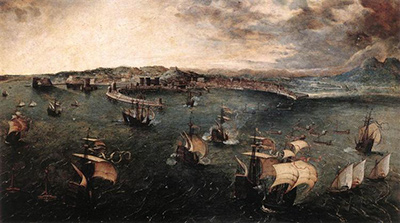Naval Battle in the Gulf of Naples was painted by Dutch artist Pieter Bruegel the Elder between 1558 and 1562, years after visiting cities in Italy, including Naples, with the famous geographer Abraham Ortelius.
What is interesting about this painting is that it is not based on an actual historical event, despite possible first impressions.
There have undoubtedly been battles in Naples, but this particular image is not inspired by any specific battle. Bruegel came up with this image of a naval battle while visiting Naples.
He even changed the circular wharf coming out into the ocean seeing as though it is not accurate of the city's actual waterfront.
Considering this was painted during the Renaissance in the Netherlands, there are various aspects reflective of the change in ideas and practices. Firstly is the fact that Bruegel used artistic licence to depict a naval battle in Naples rather than portraying real history.
A second and very significant aspect revealed in this painting is the relationship between humanity and nature.
The power of the volcano featured on the right edge of the painting, Mount Vesuvius, is part of an idea from the Renaissance, called pantheism. This idea describes nature as being a powerful, mysterious force that combines with humanity to form an all-encompassing Divine that animates the universe.
The style of this painting is also very emotive and powerful.
Through Bruegel's work, one can sense the wind pushing the ships towards shore and can feel the power of the waves.
The ominous clouds also give a sense that something dark and dangerous is happening, amplified by the darkness of the volcano. Naval Battle in the Gulf of Naples is fittingly housed today in the Galleria Doria Pamphilj in Rome, Italy.




